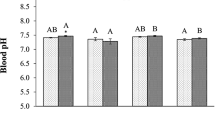Abstract
Excretion of total CO2 and uptake of sodium and chloride ions across the branchial epithelium of the posterior gills of the shore crabCarcinus maenas, collected from Kiel Bay (Baltic Sea) in 1989, were measured using isolated perfused gill preparations. Total CO2 effluxes depended on the HCO -3 concentration of the internal perfusate in a saturable mode and were inhibited by internally and externally applied acetazolamide at 10−4 M. Potential differences between hemolymph space and medium did not change significantly during experimental treatments. Neither a bicarbonate gradient (6 mM) directed from the internal perfusate to external bath solution nor symmetrically applied 10−4 M acetazolamide significantly influenced the influxes of Na+ and Cl−. Results confirmed the role of carbonic anhydrase in CO2 excretion but called into question the assumed functioning of the enzyme in branchial ion transport processes.
Similar content being viewed by others
Literature cited
Aldridge, J. B., Cameron, J. N. (1979). CO2 exchange in the blue crab,Callinectes sapidus (Rathbun). J. exp. Zool. 207: 321–328
Böttcher, K., Siebers, D., Becker, W. (1990a). Carbonic anhydrase in branchial tissues of osmoregulating shore crabs,Carcinus maenas. J. exp. Zool. 255: 251–261
Böttcher, K., Siebers, D., Becker, W. (1990b). Localization of carbonic anhydrase in the gills ofCarcinus maenas. Comp. Biochem. Physiol. 96B: 243–246
Broun, G., Selegny, E., Tran Minh, C., Thomas, D. (1970). Facilitated transport of CO2 across a membrane bearing carbonic anhydrase. Fedn eur. biochem. Soc. (FEBS) Lett. 7: 223–226
Burnett, L. E. (1984). CO2 excretion across isolated perfused crab gills: facilitation by carbonic anhydrase. Am. Zool. 24: 253–264
Burnett, L. E., Dunn, T. N., Infantino Jr., R. L. (1985). The function of carbonic anhydrase in crustacean gills. In: Gilles, R., Gilles-Baillien, M. (eds.) Transport processes, iono- and osmoregulation. Springer-Verlag, Berlin, p. 159–168
Burnett, L. E., McMahon, B. R. (1985). Facilitation of CO2 excretion by carbonic anhydrase located on the surface of the basal membrane of crab gill epithelium. Respir. Physiol. 62: 341–348
Burnett, L. E., Towle, D. W. (1990). Sodium uptake by perfused gills of the blue crab,Callinectes sapidus. Effects of ouabain and amiloride. J. exp. Biol. 149: 293–305
Burnett, L. E., Woodson, P. B. J., Rietow, M. G., Vilicich, V. C. (1981). Crab gill intra-epithelial carbonic anhydrase plays a major role in hemolymph CO2 and chloride ion regulation. J. exp. Biol. 92: 243–254
Cameron, J. N. (1978). NaCl balance in blue crabs,Callinectes sapidus, in fresh water. J. comp. Physiol. 123: 127–135
Cameron, J. N. (1979a). Effects of inhibitors on ion fluxes, trans-gill potential and pH regulation in freshwater blue crabs,Callinectes sapidus (Rathbun). J. comp. Physiol. 133: 219–225
Cameron, J. N. (1979b). Excretion of CO2 in water-breathing animals. Mar. Biol. Lett. 1: 3–13
Ehrenfeld, J. (1974). Aspects of ionic transport mechanisms in crayfishAstacus leptodactylus. J. exp. Biol. 61: 57–70
Gros, G., Forster, R. E., Dodgson, S. J. (1988). CO2/HCO −3 equilibria in the body. In: Häussinger, D. (ed.) PH Homeostasis, mechanisms and control. Academic Press, London, p. 203–231
Gutknecht, J., Bisson, M. A., Tosteson, F. C. (1977). Diffusion of carbon dioxide through lipid bilayer membranes. Effects of carbonic anhydrase, bicarbonate, and unstirred layers. J. gen. Physiol. 69: 779–794
Henry, R. P. (1984). The role of carbonic anhydrase in blood ion and acid-base regulation. Am. Zool. 24: 241–251
Henry, R. P. (1987). Membrane-associated carbonic anhydrase in the gills of the blue crab,Callinectes sapidus. Am. J. Physiol. 252: 966–971
Henry, R. P. (1988a). Subcellular distribution of carbonic anhydrase activity in the gills of the blue crab,Callinectes sapidus. J. exp. Zool. 245: 1–8
Henry, R. P. (1988b). Multiple functions of carbonic anhydrase in the crustacean gill. J. exp. Zool. 248: 19–24
Henry, R. P., Cameron, J. N. (1982a). The distribution and partial characterization of carbonic anhydrase in selected aquatic and terrestrial decapod crustaceans. J. exp. Zool. 221: 309–321
Henry, R. P., Cameron, J. N. (1982b). Acid-base balance inCallinectes sapidus during acclimation from high to low salinity. J. exp. Biol. 101: 255–264
Henry, R. P., Cameron, J. N. (1983). The role of carbonic anhydrase in respiration, ion regulation and acid-base balance in the aquatic crabCallinectes sapidus and the terrestrial crabGecarcinus lateralis. J. exp. Biol. 103: 205–225
Henry, R. P., Wheatly, M. G. (1988). Dynamics of salinity adaptations in the euryhaline crayfishPacifasticus leniusculus. Physiol. Zoöl. 61: 260–271
Maren, T. H. (1967). Carbonic anhydrase: chemistry, physiology, and inhibition. Physiol. Rev. 47: 595–781
Maren, T. H. (1977). Use of inhibitors in physiological studies of carbonic anhydrase. Am. J. Physiol. 232: 291–297
Onken, H., Graszynski, K. (1989). Active Cl− absorption by the Chinese crab (Eriocheir sinensis) gill epithelium measured by transepithelial potential difference. J. comp. Physiol. 159: 21–28
Randall, D. J., Wood, C. M. (1981). Carbon dioxide excretion in the land crab (Cardisoma carnifex). J. exp. Zool. 218: 37–44
Siebers, D., Lucu, C., Winkler, A., Dalla Venezia, L., Wille, H. (1986). Active uptake of sodium in the gills of the hyperregulating shore crabCarcinus maenas. Helgoländer Meeresunters. 40: 151–160
Siebers, D., Winkler, A., Lucu, C., Thedens, G., Weichart, D. (1985). Na-K-ATPase generates an active transport potential in the gills of the hyperregulating shore crabCarcinus maenas. Mar. Biol. 87: 185–192
Smith, R. G. (1988). Inorganic carbon transport in biological systems. Comp. Biochem. Physiol. 90: 639–654
Truchot, J. P. (1975). Blood acid-base changes during experimental emersion and reimmersion of the intertidal crabCarcinus maenas (L.). Respir. Physiol. 23: 351–360
Truchot, J. P. (1979). Mechanisms of the compensation of blood respiratory acid-base disturbances in the shore crab,Carcinus maenas (L.). J. exp. Zool. 210: 407–416
Wheatly, M. G., Henry, R. P. (1987). Branchial and antennal gland Na+/K+-dependent ATPase and carbonic anhydrase activity during salinity acclimation of the euryhaline crayfishPacifastacus leniusculus. J. exp. Biol. 133: 73–86
Author information
Authors and Affiliations
Additional information
Communicated by O. Kinne, Oldendorf/Luhe
Rights and permissions
About this article
Cite this article
Böttcher, K., Siebers, D., Becker, W. et al. Physiological role of branchial carbonic anhydrase in the shore crabCarcinus maenas . Mar. Biol. 110, 337–342 (1991). https://doi.org/10.1007/BF01344352
Accepted:
Issue Date:
DOI: https://doi.org/10.1007/BF01344352




